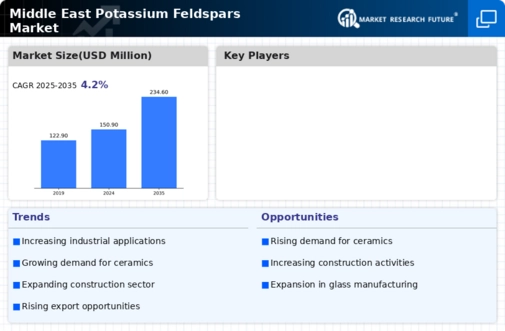Middle East Potassium Feldspars Size
Middle East Potassium Feldspars Market Growth Projections and Opportunities
The Middle East K-Feldspar market is subject to various market factors that collectively mold its dynamics. One of the primary influencers is the region's construction sector, a major consumer of K-Feldspar. As construction activities surge or wane, the demand for K-Feldspar, widely used in ceramics and glass production, experiences corresponding fluctuations. The growth of infrastructure projects, urban development, and real estate ventures in the Middle East significantly impacts the market, making it particularly sensitive to changes in construction trends and investment patterns.
MEA K-Feldspar Market is projected to be worth USD 191 Million by 2030, registering a CAGR of 4.20% during the forecast period (2022-2030)
Geopolitical factors also hold considerable sway over the Middle East K-Feldspar market. The availability and accessibility of K-Feldspar deposits are often concentrated in specific regions, and geopolitical events in these areas can disrupt the market supply chain. Political instability, trade tensions, or regional conflicts can lead to fluctuations in production, export, and pricing, affecting the overall market equilibrium. The Middle East's geopolitical landscape is thus a critical consideration for stakeholders in the K-Feldspar market.
Market regulations and trade policies within the Middle East further shape the K-Feldspar market. Changes in mining regulations, export restrictions, or government policies regarding natural resources directly impact the production and distribution of K-Feldspar. Compliance with local regulations and understanding the geopolitical and regulatory environment is crucial for businesses operating in the Middle East K-Feldspar market.
Environmental considerations are increasingly influencing the market dynamics in the Middle East. With a growing emphasis on sustainable practices, the K-Feldspar market faces pressures to adopt environmentally friendly extraction and processing methods. Companies that align their operations with these environmental concerns may gain a competitive advantage in the market, as sustainability becomes a key factor in decision-making for both businesses and consumers.
Technological advancements also play a role in shaping the Middle East K-Feldspar market. Innovations in mining techniques, processing technologies, and product applications can enhance efficiency, reduce production costs, and open up new possibilities for K-Feldspar usage. Staying abreast of these technological developments is crucial for companies seeking to remain competitive and capitalize on emerging opportunities in the market.
The Middle East's economic conditions are a pivotal factor influencing the K-Feldspar market. As economic growth and industrialization continue in the region, the demand for K-Feldspar in various applications, including ceramics, glass, and construction, is likely to witness an upward trajectory. Economic downturns, on the other hand, may result in reduced demand for construction materials and, consequently, impact the K-Feldspar market negatively.
Market competition is a constant consideration in the Middle East K-Feldspar sector. With multiple players operating in the market, competition revolves around factors such as product quality, pricing strategies, and customer service. Companies strive to differentiate themselves to gain a competitive edge, and the entry of new players or exit of established ones can alter the competitive landscape, influencing overall market dynamics.
Consumer preferences and industry trends also contribute to the Middle East K-Feldspar market's evolution. Changes in design preferences, demand for sustainable products, and advancements in construction techniques influence the types and grades of K-Feldspar sought by consumers. Adapting to these trends is crucial for companies looking to meet market demands effectively and stay relevant in the evolving landscape.




Leave a Comment